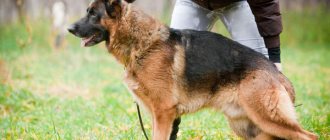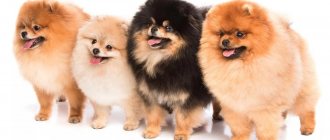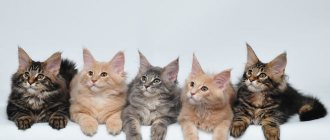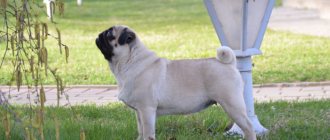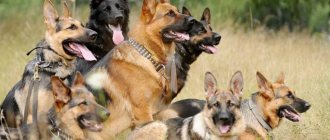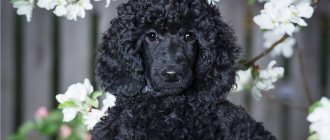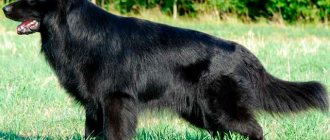It is common to see a German Shepherd in only one color – with a black V-shaped “mantle” on the back and a red underpart. But in fact, they have 3 types of suits with different variations, provided for by the standard.
In addition, there are several more colors. They are considered a marriage. But if you want an unusual dog as a pet, and not for participation in exhibitions, then you can buy an extraordinary puppy.
You can find out what colors “Germans” come in and what they look like in the photo from the article.
How do German Shepherds change color?
The color of the German Shepherd changes gradually. Most newborn puppies have dark coats that look about the same. During the molting period, it turns from smooth and soft to hard. If the puppy has a zonal type color, and the appearance of the additional color is pale brown, with age it acquires brightness and becomes red-red. A gray dog in childhood has the shade of a dirty rag. At four months the fur gradually falls out, by seven months the saddle cloth is already clearly outlined, and by one year the coat ends and the color no longer changes. During the molting period, puppies need to be looked after - combed using a comb or furminator.
Which ones are considered a defect and which ones are considered a breed?
The defective colors that require disqualification are red and white . These also include blue, golden, spotted, roan.
Such dogs are suitable only for private purposes. Their mental and physical abilities are no different from standard colored dogs. The disqualification of dogs of this color is due to the fact that this color is unacceptable for a German shepherd, but arises due to a mutation at the gene level.
Dogs with disabilities are prohibited from being allowed to breed or breed , but some breeders are very tempted to breed a supposedly rare German Shepherd to sell at a higher price . You need to be extremely vigilant so as not to fall for the bait of such scammers.
the white German Shepherd was so loved that they were not lazy and bred a whole breed . But it is recognized only on the territory of this country.
Other clubs and the FCI consider the white color for the “German” to be a defect.
All other colors are a sign of the breed. There are not many of them, but the black-and-white is the most common of all. This is primarily due to aesthetic beauty and appearance. Such shepherds are brighter, which means they attract more attention.
Black dogs often take first places at exhibitions; without them it is impossible to imagine not only border guards, but even films or TV series . This is one of the few types of breed that can be not only in the working line, but also in the exhibition line.
The Black German Shepherd is the rarest of the breed. She is considered an elite dog; such dogs are incredibly expensive.
What color are adult German Shepherds?
According to the standard, the color of the German is black, zoned and black. Some dog experts distinguish black and tan, but this is not an independent type, but only a variation of the main ones.
Currently, dogs are bred in two directions - for participation in exhibitions and for work. In the second case, what is most valued in a pet is not the color, but the service qualities, so when choosing, they focus on them. During working breeding, the colors of the representatives of the breed have a wide range. Acceptable colors for a German Shepherd include:
- ginger;
- blue;
- black and white;
- white;
- black and red;
- red;
- cream and others.
Black color
The color got its name from the saddle cloth, a bedding made of fur, carpet or cloth under a horse’s saddle. This is exactly what the pattern on the body of a German Shepherd looks like. The color of the dog's back, sides, upper tail, and elbows is black. Tan comes in a variety of shades – from red-red to chocolate. Spreads over the stomach, chest, neck and paws. A prerequisite for the black-backed color is a darkened muzzle, a black mask up to the ears. Its absence is considered a defect according to the standard.
Ginger colour
Red Germans look like they have tan marks all over their fur. They do not meet the standard; when bred for exhibitions, puppies are discarded. However, due to their spectacular appearance and rare colors, they are in great demand, so breeders of working dogs choose them and try to get offspring from red parents.
One of the color varieties is zone-red, with light and dark areas of the coat.
White
White coat occurs in German Shepherds with a recessive gene. The coloring is still controversial. It was recognized as standard only in Canada and the USA; for the rest of the world, white individuals are a defect in the breed. They cannot be considered albinos; this is not a mutation or pathology. Light Shepherds are larger than normal dogs, have a coarser coat, and are energetic, strong, and intelligent. When training, you need to be loyal; in relation to strangers, white Germans are calmer than their dark relatives.
Gray (blue)
The rarest and one of the most beautiful shades of German wool. Individuals of gray color are born due to the appearance of an additional gene that can weaken the black pigment of the coat. After some time, the gray color acquires a blue tint, and the pet looks unusual. Although the color is not recognized by dog handlers as standard, the Blue German has excellent search and guard qualities.
Black and gray shepherds are a common option. They are similar to black-backed birds, but instead of red and tan they have gray lightened areas.
Black and white
White and black spots are a deviation from the standard. This fact does not in any way detract from the merits of a service dog, although it looks like a panda. Spotted “harlequins” will not win medals at exhibitions; they will not be allowed to compete. Black and white coloring is elegant and, perhaps, will become a standard in the future, especially since the Sheltie service breed has such spotting.
Black and Tan
It is not often that you see black and tan shepherds. They belong to the saddle color and come in rich, darkened and weakened shades of tan. The color of the coat consists of dots, spots and stripes on a black background. Dark tan German Shepherds have a peculiarity - with each molt they do not darken, but become lighter. If the shade of tan is saturated, the German Shepherd with a black muzzle, body, and tail has only a small shading of brown coloring on the legs.
Black and red
The black and tan German Shepherd belongs to the saddle color. She looks spectacular, which is why these dogs most often become the winners of exhibitions. The black and tan dog has no advantages over black and zonal dogs, but the combination of rich coat colors gives the service dog additional charm. Different shades of red and tan (from light orange to brick) give the dog a unique appearance.
Red
Red fur is considered to be red fur with a rich tint or simply going into a crimson color. Lightening under the tail, on the chest, paws and muzzle is acceptable. The suit was rejected by the standard, despite the fact that it looks great.
Brown (chocolate)
Puppies of this rare color can appear in the litter of parents of a standard species without a genetic failure. Brown has different shades - from beige to the color of dark chocolate. The latter looks especially beautiful, has slight reddish highlights.
Cream
Another non-standard coat color of the German is cream. Its color variations are fawn, milky, yellowish, pink, and gold is especially impressive.
Sable color
The sable color is quite common and is a type of zonal. It is rare in red shepherds; a combination of black, yellow and gray shades is more often observed. The tips of the hairs and awns are black, the undercoat is smoky, and the mane and shoulders are light.
Zonar
The zonal color is called wolfish. For a long time it predominated among German shepherds. The coloring appeared thanks to the ancestor of the breed - a wolf crossed with a European dog. Over time, new colors were introduced that were fashionable and in demand. Zonar coat predominates in working line individuals participating in training competitions. Breeders are still breeding them, since this color can enhance the pigmentation of the offspring's coat and consolidate the effect for a long time.
Many owners of dogs with zonal coloring believe that they are more resilient and more efficient than others.
Spotted
A German has a spotted coat if he is a cross between a shepherd and a mongrel dog. In this case, the marks are arranged randomly and have different shapes and sizes. Their color ranges from white to red.
Deviations from the color standard
The unusual colors of the “Germans” are a rare phenomenon and attract attention. Any deviation from the norm is considered a defect. Such dogs are not suitable for exhibitions and breeding. The color of the coat does not affect the health, development, or character of the puppy, so they will become excellent family friends, these are representatives of the so-called “pet class”.
Roan
This is rather not a separate subtype, but a result of age-related changes. As the dog ages, it begins to “grey”; the coat loses pigment, saturation, and turns pale. Individual light hairs may appear on the face and body . If gray hair begins to predominate, then the color is called roan.
But this phenomenon is also typical for young dogs. This is not considered a pathology, the dog is not sick and does not age too quickly. Just a genetic predisposition to early bleaching.
In the photo there is a roan shepherd dog
Gray (Blue)
Other names: blue, silver, asphalt. Occurs due to a genetic mutation associated with a decrease in black pigment in the litter. Simultaneously with the coloring of the cover, the tone of the iris can lighten, but this phenomenon is rare.
Despite their attractiveness, puppies of this color are discarded. Although in the USA, breeders specifically try to get blue babies with one striking feature - golden-yellow eyes. Perhaps, in tens of years, a new breed of German Shepherds will emerge.
In the photo there is a blue-gray shepherd dog
White
This type of shepherd color, although not considered standard, is held in high esteem by Americans. In the USA they believe that such dogs are the most gentle, kind and family-friendly. In addition, light dogs are distinguished by their “musicality”; they love to sing and howl.
This color in the shepherd's genes is not an accident, because the first German was dirty white, which means his ancestor had light hair.
If the puppy's parents are carriers of a recessive gene, it will have a snow-white coat. This is a unique phenomenon; representatives of the white color are very beautiful, but are considered a deviation from the standard.
It is impossible to say that they are albinos. They have brown eyes, dark claws, and a black nose. Shepherd dogs do not have the albinism gene, so even white dogs do not suffer from deafness (which is typical for cats, for example).
The photo shows a white shepherd
Red and yellow
Despite their impressive appearance, such “Germans” are rejected because they do not meet standard requirements. It is worth distinguishing them from red (rich red) tan or red zone, which are recognized by canine collections. The saturation of shades can be very diverse.
“Sunny” dogs, despite their non-standard nature and exclusion from the breeding branch, will make excellent pets.
In the photo there is a red shepherd dog
Golden
A variation of the yellow color occurs when a certain pigment appears, the coat becomes lighter, and shimmers like gold in the sun. With all this, dark tones predominate on the face, and a mask is characteristic.
In the photo there is a golden shepherd dog
Spotted
From the name you can see that the cover of representatives of this color is characterized by the presence of pigment spots of different shades and sizes. Their location is not determined by anything; they are scattered throughout the body.
As a rule, such shepherd dogs are crossbreeds of “Germans” with “Australians”, as well as with representatives of other breeds, mongrels.
The photo shows a spotted shepherd dog
Black and white
Another non-standard color. The spotting is quite original. Puppies of this color resemble cute pandas. Color deviation does not reduce other advantages.
Although black shepherds are allowed to have a small white spot on their chest.
In the photo there is a black and white shepherd dog
Brown
The chocolate color of the coat of German Shepherds is a defect. You cannot send such dogs to a show, but they will become good friends and reliable protectors of your home.
The characteristic brown color of the coat is the “Gypsy” German Shepherd, which is much smaller than the standard size, but is popular with shepherds in the Czech Republic.
The photo shows a brown shepherd
brindle
In the owners of this extraordinary species, a certain gene predominates. It seems to draw black stripes on the dog's fur. It is extremely rare to see such a color in a German Shepherd.
To get a puppy of this type, one of the parents must be brindle. This coat color is typical for Dutch Shepherds.
In the photo there is a brindle shepherd dog
German eye and skin colors
According to the standard, the German Shepherd's eyes are dark, but not black. This is not the only option. A German with a light coat color may have dark brown eyes, while a black German may have light eyes. There are different combinations, but it is believed that the most successful, giving maximum expressiveness, is a dull muzzle and chocolate eyes. Gray shepherd dogs with blue eyes and white ones with dark eyes look beautiful.
The eye rims of the Germans are of a rich shade, black spots are visible on the tongue, the skin is grayish, and the tan areas are pink. Black individuals have dark skin throughout, including the ears and anus.
Black and tan color
Such dogs may appear completely black due to the predominance of black color, pronounced black mask, and black undercoat. The overall dark tone is diluted only by brown strokes on the paws. There are 3 varieties of black and tan color - rich, darkened and weakened.
Important! The pale black and tan is often indistinguishable from the black zone, as it displays a large amount of black on a barely gray undercoat, brown/gray along the shoulder and along the top of the neck, and black markings on the toes and paws.
These German Shepherds are genetically predisposed to "fading" the black mantle: they convey a weakened color, although they themselves appear quite dark. It should be remembered that black and tan dogs always have a tan mark near the anus.
Return to content
Which is better German Shepherd - black or black?
Every dog lover answers this question in his own way. Black coloring is more common; a German is immediately recognized by it. The richer the tones of the coat, the stronger the health; a weakened dog signals the degeneration of the line. When a black-backed puppy is born, it is very dark, then it becomes lighter, but the final appearance is formed by the age of three.
Black Shepherds are born and remain coal-colored for the rest of their lives. They are incredibly popular due to their rich anthracite color, harmonious overall appearance and high performance.
Black color
This is the most common color of the breed and is also known as black and tan. Its popularity is explained not by any advantages over black or zone-gray (all colors of German shepherds are equal), but by its effectiveness. It has already become a pattern that over the past decades, champion titles at special breed exhibitions have gone to black-and-white shepherd dogs.
Black and red color is also available in three varieties:
- weakened black-and-white;
- darkened black-and-white;
- rich black.
The saddle dog has a deep brown base of hair and the obligatory black “saddle blanket” (like a horse’s blanket), consisting of a guard coat that is completely black. A black mantle covers the top of the neck, shoulders, back and then goes down to the belly, rump and tail.
Important! Often gray or brown hair is observed on the neck and back, reaching the tail, and this is quite normal. Gray/brown hair on the croup or sides, as well as the light end of the tail, will indicate a weakening of the color.
Bitches (even very dark ones) often have “salt and pepper” on the back/withers, which can also be found in males, but not in dark ones, but with a weakened color. By the way, the pale saddleback and the light zonular are often confused due to their extreme similarity. Very dark black-backed shepherd dogs with a black head, withers and body are often passed off as black and tan. However, upon closer inspection, they have slight brown shading at the base of the ears and some dark hair on the metatarsus, toes or hocks.
Return to content
Dimensions, weight and description
The German Shepherd is a fairly large breed, so if you take it to live in an apartment, you need to familiarize yourself with the standards. Dog characteristics:
- The height and weight of adult males is 60-65 cm, 30-40 kg, females - 55-60 cm, 22-30 kg.
- The body is slightly stretched, the back is wide, muscular, the chest is deep.
- The head is wedge-shaped, small, tapering towards the nose.
- The ears are wide, triangle-shaped, and set high.
- The eyes are almond-shaped and dark brown.
- The limbs are smooth, straight, well developed.
- The tail is saber-shaped, slightly curved.
The Zonar Shepherd can be short-haired or long-haired.
Pet Personality
Zonal “Germans” are characterized by such traits as a strong nervous system, balanced temperament, innate protective instinct, alertness, courage, activity and determination.
NOTE!
These are loyal and obedient dogs: friendly towards the owner and members of his family, but at the same time distrustful of strangers.
The zone-colored German Shepherd does not show causeless aggression towards strangers or animals. She is very human-oriented, and, as a rule, strictly follows all the orders of the owner.
A zoned shepherd dog must understand when aggression is appropriate and show it only in situations where it is necessary to protect the owners or their property..
Read more about the German Shepherd's personality here.
Origin story
Zonar coloring dates back to antiquity. The ancestor of German shepherds, Horand von Grafrath, was distinguished by an intense ash-colored color, which was passed on to most of his descendants. At the beginning of the 20th century, all BUTs looked exactly like this, but over time, dogs with black-and-white colors came into fashion.
Nowadays, it is extremely rare to see zonal winners at exhibitions, since judges prefer the brighter and more contrasting saddle color. However, shepherd dogs with this coat color are leaders in training and in sporting competitions.
Breeders of show dogs do not abandon the zonal color, as this coloring enhances and consolidates pigmentation for many generations. Therefore, in kennels, from time to time, the blood of zonal sires is added to black-haired shepherd dogs.
Founder of the German breed
Rules of care
Caring for a German Shepherd is not difficult .
It is enough to brush the dog 3 or 4 times a week, and when the pet sheds, then every day. At the same time, to prevent fur from accumulating in the house, you can comb out the dead undercoat in advance with a special mitten or a furminator.
CAREFULLY!
It is recommended to inspect your pet's ears, eyes and mouth every day and clean them if necessary.
A German Shepherd's claws usually do not need to be trimmed: they grind themselves down just fine while walking on hard surfaces. If this becomes necessary, you can use a nail clipper for large dogs.
In order to keep the dog's coat in good condition and not cause allergies to detergents, it is recommended to bathe zoned shepherd dogs no more often than once every 2-3 months.
Life expectancy and health
Zone Shepherds, like most large breeds, live 10-14 years. The dog's immunity is strong and they rarely get sick. Despite this, they can develop diseases that often affect all shepherd dogs:
- hip dysplasia;
- food allergies;
- gastric volvulus;
- otitis;
- dermatitis, eczema.
Important! The German Shepherd is very sensitive to infectious diseases, so dogs must be vaccinated from 2 months of age.
Pigmentation of the muzzle
A special dominant gene is responsible for the black mask (muzzle before and around the eyes), which gives the shepherd dog the expressiveness of the breed. A well-pigmented German Shepherd may have a weakened mask, while a lightly colored one, on the contrary, may have a strong mask.
Dark areas of the eyebrows/forehead are linked to the base color at the genetic level: a dog with an expressionless saddle coat often shows a light forehead, while a deep black mantle “attracts” a black forehead. The unmasked Black and Tan Shepherd resembles a Doberman Pinscher - it has a black muzzle, brown throat and liver-shaped lips. A dog with a zonular color has a sable tint to the eyebrows.
Return to content
Not the standard red color
A completely red shepherd is a deviation from the standards of this breed. Such a dog will not be taken to participate in an exhibition, and in general, shepherd dogs with a purely golden shade of fur are very rarely found in nature. Animals that have reddish tan or a red color present on the “fur coat” in some places are allowed for exhibitions.
Of course, a pet with a completely golden hair color looks very beautiful and bright, but this type of hair color is recognized by the International Canine Federation as defective, and even defective, that is, unsuitable for breeding.
In conclusion, we add that in order to accurately determine what color puppies will be born to a female and male German Shepherd, you need to clearly know their pedigree. For a more precise analysis, you can contact experienced breeders and dog handlers who will conduct a DNA test on the parents and answer the question posed.
How to choose?
First of all, you need to decide: what is such a dog for - for work, sports or for exhibitions? Based on this, you need to select suitable working or exhibition lines.
But, in any case, you need to buy a puppy only with documents of origin.
When purchasing a working dog, it is advisable to inquire whether the puppy’s parents have training diplomas . Also, the mother and father of the future pet must have medical certificates stating that they are free from hereditary diseases.
IMPORTANT!
When choosing a puppy, in addition to its exterior characteristics, you need to pay attention to the state of health, the quality of raising and the psyche: the baby should be cheerful, active and active, and, moreover, not thin and not too small.
When choosing a show pet, experts recommend choosing a medium-sized puppy.
Before you finally decide on one or another baby in the litter, you need to carefully examine it so as not to miss signs of possible illness . Sick puppies should not be adopted under any circumstances.

